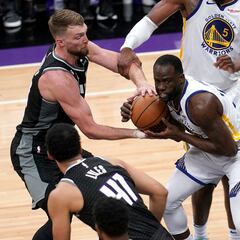Why are NBA playoff series played to the best of 7 games?
Throughout the history of the NBA the Finals have always been best-of-seven but there have been various different formats in previous rounds.

The NBA had employed the best-of-seven series format, at least in the NBA Finals, since the 1946-47 season, when the Basketball Association of America was the governing body—that year featured 11 teams who each played 60 regular season games, after which the inaugural BAA Playoffs in 1947 were held.
Chicago and Washington played a best-of-seven series after going straight to the Divisional semifinals (there were no conferences at the time), with Chicago winning 4-2, while New York, Cleveland, St Louis, and Philadelphia contested best-of-three series in the first round, with the Philadelphia Warriors (the precursor to Golden State) beating New York 2-0 in the other semifinal before routing Chicago 4-1 in the finals.
The Warriors are one of only three teams from that season still in existence, alongside the Boston Celtics and the New York Knicks.
Best-of-seven through NBA history
The best-of-three series format was maintained for playoff rounds (with a round-robin Division Round flirted with in 1954 but swiftly abandoned) until 1955 when Division Finals moved to best-of-five. In 1958, these were switched to a best-of-seven, and in 1961 the Division Semifinals also moved to a best-of-five. The Finals themselves remained a best-of-seven series throughout this era. It wasn’t until 1968 that the entire NBA playoffs were contested on a best-of-seven format.
NBA playoffs:
- Kings hand Warriors first 0-2 in the playoffs in the Steph Curry era
- Bucks optimistic that Giannis can play in Game 2
- Russell Westbrook involved in verbal fight with Suns fans
- The Spurs end with the NBA’s worst defensive figures in 30 years...
- Has Steph Curry ever been eliminated in the first round of the playoffs?
The reasoning for switching the format was simple enough: best-of-seven series meant more money for broadcasters and more money for teams playing at home.
Last year, for example, the Golden State Warriors pocketed $100m through playoff games at the Chase Center alone. Steve Kerr’s team played nine home games to win the Western Conference, earning $72m: $7m for each of nine games in the first two rounds and $9m for their two conference finals games against the Mavericks in San Francisco. The Warriors were guaranteed at least two home games in the NBA Finals, earning $15m each.
Game 7, the NBA Playoffs norm
Related stories
Throughout the history of NBA Playoffs, there have been 145 Game 7s. Of those, only six have gone into overtime, and just one required double overtime to determine a winner. The visiting team emerged victorious in 34 out of the 145 games, and every existing franchise in the NBA has participated in at least one of these high-pressure games. Surprisingly, there have been only 12 instances when an entire playoff schedule has concluded without a Game 7, and three of those times (1994, 2014, and 2016) didn’t even necessitate a Game 6.
In a single playoff, the LA Lakers in 1988 and the New York Knicks in 1994 have won the most Game 7s. The format for the NBA Finals is identical to the rest of the playoffs, which is 2-2-1-1-1. The team with the superior regular season record enjoys home-court advantage for the first two games, and if necessary, the fifth and seventh games are also played on their home court. Since 2014, the original format has been reinstated, replacing the 2-3-2 structure introduced in 1985 to minimize travel between games.

